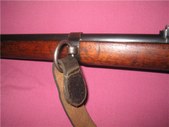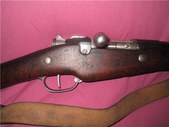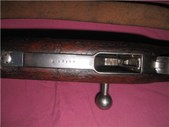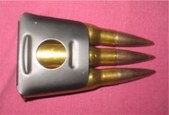
1
Left side view of the rifle.
| 
2
Muzzle, bayonet lugs, and stacking hook.
| 
3
Ring style front sling mount with correc Berthier sling.
| 
4
Serial number. The "CC" refers to the subcontractor that provided the steel for the barrel.
|

5
The maker's rollmark and model number stamping.
| 
6
View of buttstock.
| 
7
Serial number stamped into the buttstock. Note that is has been stamped over an older number. This stock could have been recycled during original manufacture (common French practice in WW1), or added at a later refurbishment. No way to know now.
| 
8
Right side view of rifle.
|

9
View of stacking hook.
| 
10
Barrel Band. Note it is retained by a band spring on the bottom of the stock.
| 
11
EDB 1916 refers to Etablissement Delauney Belleville. 1916 is the year of manufacture.
| 
12
Action view.
|

13
Bayonet lugs and muzzle.
| 
14
View of the matching serialized bottom metal. The opening is where the empty charger clip exits the rifle once all 3 rounds have been spent.
| 
15
View of the bolt.
| 
16
View of receiver interior. Note it is in the white - reblued rifles will have a blued interior. These rifles would have been rust blued when new.
|

17
The "N" markigns denoting a chamber modified to fire Balle N.
| 
18
Rear sight. Note the holes that used to be filled with radium.
| 
19
Front sight. Note lead filled hole that used to be painted over with radium.
| 
20
charger clip holding 3 rounds of 8x50R Lebel (Balle D).
|

21
Markings on the sling, indicating manufacture on November 15, 1945 in Paris. These rifles were issued well past WW2, especially in colonial regions.
| |

